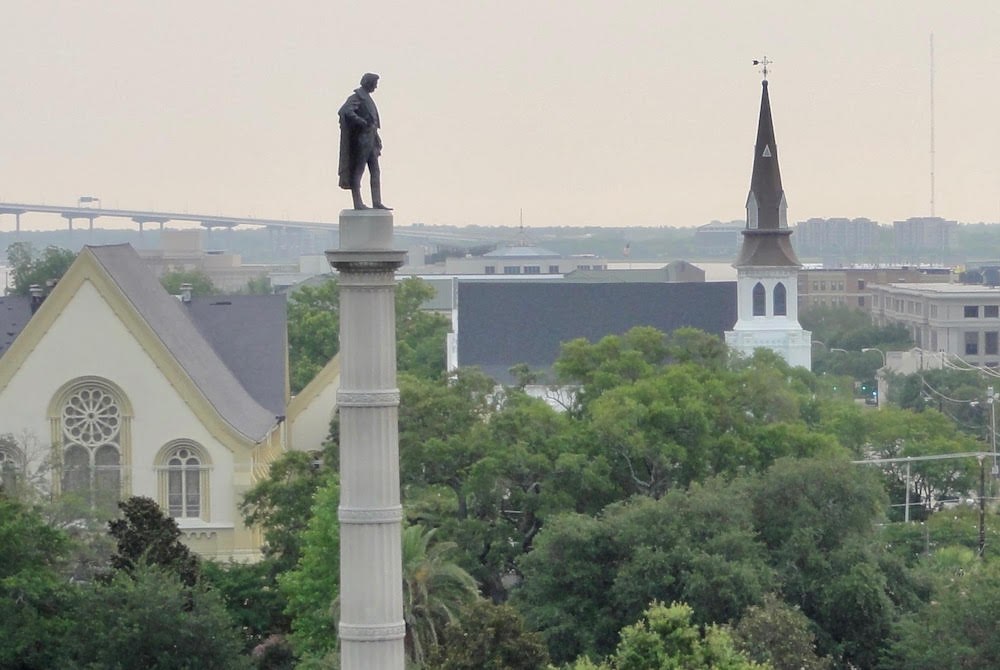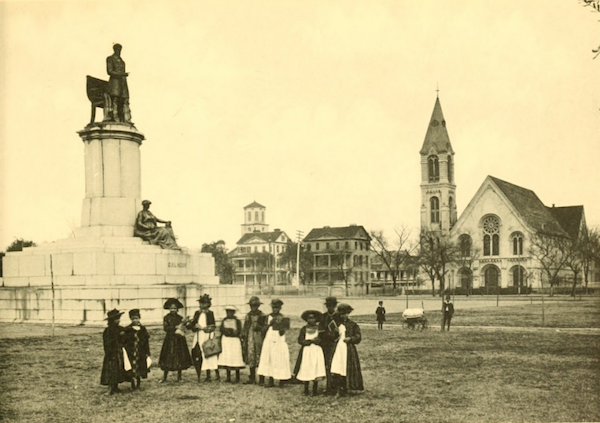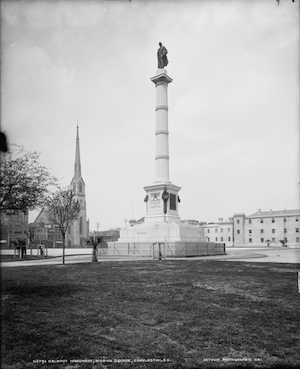
The Calhoun Monument and Emanuel AME church today. Photo by Ethan Kytle.
 In the center of Charleston, South Carolina, in a verdant green space that plays host to farmers markets, festivals, and sunbathing undergraduates, stands a monument of John C. Calhoun, the antebellum South Carolina statesman who famously called Southern slavery “a positive good.” His bronze likeness rises over 100 feet in the air, squaring off against its symbolic rivals, including the copper-shingled steeple of Emanuel A.M.E. Church, where a white supremacist brutally gunned down nine African-American parishioners in 2015.
In the center of Charleston, South Carolina, in a verdant green space that plays host to farmers markets, festivals, and sunbathing undergraduates, stands a monument of John C. Calhoun, the antebellum South Carolina statesman who famously called Southern slavery “a positive good.” His bronze likeness rises over 100 feet in the air, squaring off against its symbolic rivals, including the copper-shingled steeple of Emanuel A.M.E. Church, where a white supremacist brutally gunned down nine African-American parishioners in 2015.
In one sense, the Calhoun Monument is a remarkably honest, and conspicuous, acknowledgment of Charleston’s dedication to slavery, even after its abolition in 1865. Here in the capital of American slavery—the city where nearly half the enslaved persons brought to the United States first stepped foot on our shores, and where Confederate troops fired the opening shots in a war launched to defend slavery—a group of elite white women worked for decades to honor slavery’s great champion with a statue.
Yet the Calhoun Monument tells another, less visible story, too—one of black resistance to those commitments. The lesser-known history of protest against this statue, and against a similar one it replaced, is as integral to its existence as anything Calhoun and his supporters advocated. For over 100 years, critics of these two Calhoun memorials have waged war against statues they see as the ultimate symbols of white supremacy.
The battle over the Calhoun Monuments is just one front in a larger struggle over how slavery should be remembered in Charleston and across the country. As early as 1865, former slaveholders and their descendants began working to construct a whitewashed memory of the antebellum South, downplaying or even ignoring slavery at times, only to cast it as benevolent and civilizing in other moments. In contrast, formerly enslaved persons, their descendants, and some white allies have worked to preserve an honest, unvarnished account of slavery as the cruel and pervasive institution that it was.
Nothing better encapsulates the whitewashed memory of slavery than the Calhoun Monuments, and nothing better encapsulates the unvarnished memory than the long campaign against them.
The Ladies’ Calhoun Monument Association actually began its crusade to erect a Calhoun memorial not long after the statesman’s death in 1850. Calhoun’s distinguished political career was certainly a factor in their decision. He had served as a congressman, senator, secretary of war, and vice president over his 40 years of public service. But another reason loomed larger. During his tenure in office, Calhoun had been the white South’s most dogged defender.
When northern reformers flooded the nation with antislavery petitions and pamphlets in the mid-1830s, for instance, then-Senator Calhoun led protests in Washington, D.C. Abolitionism, he insisted, “strikes directly and fatally, not only at our prosperity, but our existence, as a people…. It is a question, that admits of neither concession, nor compromise.” Far from a necessary evil, as early American slaveholders like George Washington and Thomas Jefferson had framed the institution, slavery, insisted Calhoun, was a positive good that benefited slaveholders and the enslaved alike. Although Calhoun did not live to see the Civil War, he was the ideological godfather of the Confederate cause.
Yet the bloody conflict that began in Charleston Harbor in 1861 slowed the Ladies’ Calhoun Monument Association’s progress on their memorial to Calhoun, and the final months of the war unleashed a wave of vandalism against anything associated with the proslavery statesman. Calhoun’s gravesite was desecrated by multiple parties, and a formerly enslaved person destroyed a bust of Calhoun that she found in the offices of the Charleston Mercury, the city’s leading secessionist newspaper.
Empowered by the occupying Union Army, Charleston’s freedpeople made sure that the unvarnished memory of slavery predominated in their hometown, at least in the short term. In the spring of 1865, they orchestrated a striking parade featuring a mock slave auction and a hearse, carrying a coffin, on which were inscribed the words “Slavery Is Dead.” Annual Emancipation Day and Fourth of July parades celebrating black freedom flourished into the 1870s, when the biracial, progressive Republican Party controlled Reconstruction in South Carolina.

This 1892 photograph of Marion Square shows the first version of the memorial to John C. Calhoun, which was later replaced. The figure at the base of the statue is Justice. Photo by A. Wittemann. Courtesy of Wikimedia Commons.
The Ladies’ Calhoun Monument Association did not resume their work in earnest until after white conservatives resumed power across the state and brought Reconstruction to a close in 1877. Finally, a decade later, in April 1887, the association unveiled its statue in Marion Square, a park in the heart of Charleston. At the top of a massive pedestal, Calhoun, cast in bronze, appeared to be just rising from his chair to speak, his right index finger pointed outward. The statue was to have been surrounded by four female allegorical figures representing Truth, Justice, History, and the Constitution, though only one—Justice—was actually installed.
The location of the monument was imbued with symbolism. Marion Square was home to the Citadel, the military college that was originally founded as an arsenal to better police the enslaved population of Charleston after a failed 1822 slave insurrection. The ladies hoped that with Calhoun’s stern countenance watching over them, Citadel cadets might learn to “emulate the virtues of the great statesman.” It was also where the Slavery Is Dead parade had begun and ended back in 1865.
The Calhoun statue was one of hundreds of Confederate and other white supremacist monuments that were erected in the same period. Like most of these tributes, the Calhoun Monument didn’t mention slavery. Yet it signaled an attachment to the racial ideology of the Old South in a more direct fashion than other Lost Cause memorials: Calhoun was featured standing up, both literally and figuratively, for his region’s interests, on the Senate floor, so that the monument harkened back to a time when the Civil War’s precipitating cause—slavery—occupied the energies of South Carolina’s politicians. And at the dedication ceremony on April 26, the keynote speaker, Lucius Quintus Cincinnatus Lamar, a former Confederate officer from Mississippi, discussed the institution Calhoun had fought so hard to defend. True, Lamar admitted, slavery was dead, but during its time the institution had been beneficial, especially because it had “civilized” the enslaved.
Black Charlestonians also viewed Calhoun and the statue erected in his honor through the lens of slavery, albeit from a different angle. Elijah Green, who claimed that as a young enslaved boy he had helped dig Calhoun’s grave, once said: “I never did like Calhoun ’cause he hated the Negro; no man was ever hated as much as him by a group of people.”
Thus, when the monument went up in Marion Square, African Americans like Green may not have been surprised—whites were at that very moment implementing a segregationist regime, after all. But they were outraged. They knew exactly why the Ladies’ Calhoun Monument Association had never abandoned its project, despite nearly three decades of challenges. Indeed, the long delay in the monument’s construction provided a new use for Calhoun’s ideology in the present.
“Blacks took that statue personally,” remembered Mamie Garvin Fields, born in Charleston in 1888, one year after the Calhoun Monument was installed. “As you passed by, here was Calhoun looking you in the face and telling you, ‘Nigger, you may not be a slave, but I am back to see you stay in your place’…he looked like he was telling you there was a place for ‘niggers’ and ‘niggers’ must stay there.” In Fields’s and other black Charlestonians’ eyes, the Calhoun Monument invoked slavery to justify segregation. “I believe white people were talking to us about Jim Crow through that statue.”
Black Charlestonians talked back as best they could, given the strictures of Jim Crow. “We used to carry something with us,” Fields explained, “if we knew we would be passing that way, in order to deface that statue—scratch up the coat, break the watch chain, try to knock off the nose.” Local newspapers are full of stories documenting this campaign of guerrilla vandalism in the late 1880s and 1890s. In one instance, a young black boy shot a tiny pistol at the statue. In another, the face of Justice, the allegorical figure, was painted white under the cover of darkness.
Although the racial identity of the whitewashers was left unmentioned, the press invariably noted that black Charlestonians were responsible for the other major form of attack against the monument: relentless mockery. Justice bore the brunt of African Americans’ verbal volleys. They dubbed the lone, curiously out-of-place figure who sat at Calhoun’s feet ‘he wife,’ or Calhoun’s wife, in the local Gullah dialect.
From the beginning, in other words, Charleston’s black community transformed the Ladies’ Calhoun Monument Association’s white supremacist shrine into an object of vandalism and ridicule.
By the early 1890s, the association had determined to remove the Calhoun Monument and install a replacement. The women publicly explained that they had always felt the original monument could have been more aesthetically pleasing. Historical evidence suggests, however, that black defacement and mockery played a role in their decision to erect a second statue in 1896, the one that still stands today and that is, significantly, much taller than the first.

The second Calhoun Monument, erected in 1896. Courtesy of the Library of Congress.
The Ladies’ Calhoun Monument Association likely assumed that this new Calhoun, perched on his column over 100 feet in the air, was now out of harm’s way. They were mistaken. Although a fence and lights were installed as defensive measures, the vandalism continued for decades. “Wanton mutilation,” officials complained, kept necessitating repairs into the mid-20th century. Oral history indicates that some of the vandals targeted the new monument specifically because of Calhoun’s outspoken stance on slavery. This was certainly true of the protestors who defaced the Calhoun Monument after the murders at Emanuel A.M.E. Church in 2015. They painted the word “racist” in red near the base of the statue and modified the monument’s engraved testament, which reads “Truth Justice and the Constitution,” by adding the words “and Slavery.”
During segregation, of course, physical and verbal attacks on the Calhoun Monuments were the only real weapons that politically disenfranchised African Americans had at their disposal. In fact, the monuments themselves helped facilitate black repression. It is no coincidence that the major wave of Confederate memorialization dovetailed precisely with the formalization of Jim Crow laws and customs throughout the South. As Confederate veteran Wiley N. Nash observed in the 1908 dedication speech for a Confederate monument in Lexington, Mississippi, “these sacred memorials, tell in silent but potent language, that the white people of the South shall rule and govern the Southern states forever.”
Wiley N. Nash, Lucius Quintus Cincinnatus Lamar, Mamie Garvin Fields—white and black citizens alike—understood why these memorials were erected across the Southern landscape. The difference, of course, was their response. Nash, Lamar, and white Southerners cheered the commemorative impulse; Fields and black Southerners denounced it.
Since the Emanuel Massacre in 2015, defenders of controversial Confederate and white supremacist monuments have offered numerous reasons why such memorials should not be taken down. A common refrain is that monument critics are using contemporary standards to unfairly judge the past. Why, they ask, should we remove memorials that honored ideals and individuals not seen as problematic at the time? As the history of the Calhoun Monuments shows, the premise underlying this query is, in fact, ahistorical. These ideals and individuals were never universally sanctioned.
Plenty of Southerners objected to men like Calhoun, what they stood for, and memorialization efforts in their honor. Indeed, in Charleston, which had a black majority in the late 19th century, it is likely that most city residents disliked the Calhoun statues when they went up. The second Calhoun Monument still towers over Charleston today, and it would take an act of South Carolina’s legislature to remove it. There is an effort underway to add a contextualizing plaque to the monument that would make clear both Calhoun’s fidelity to slavery and the white supremacist roots of the statue. But proposals to also include the monument’s many detractors have gone nowhere. The fact that the traces of opposition to the statue and the one that preceded it are difficult to see today, while the second Calhoun Monument and hundreds more like it stand in plain sight, should not diminish this more complicated—and accurate—history.




Send A Letter To the Editors